TSA Weekly, March 16-20, 2009

A Message from Gale
Peer Review: The Ultimate Form of Employee Empowerment
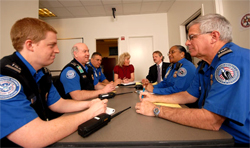
From left, STSOs Phil Lambert, Jay Anthony, Sam Romero, Kristie Hale, Don Cahoon, Joan Lawrence and Bill Schroder at Washington-Dulles International Airport. Photo by Eric Echevarria
One of our priorities for the past several years has been to create and strengthen ways for our workforce to have their voices heard, issues raised, and resolutions reached in a fair, inclusive and respectful manner. The Peer Review Program is one of the newest ways to do this at TSA.
Hopefully you've received communications about the nuts and bolts of the program that's currently in place at all Category X and I airports. If you're unaware of who, how or when you can consider Peer Review, please visit the Human Capital iShare page to learn more about the program.
In this message I'd like to talk about the benefits of the program even beyond resolving individual cases, and to share some success stories. Peer Review offers an expanded employee option for a thorough and impartial review of a wide array of workplace issues and disciplinary actions by a panel of your peers, a quick resolution and a binding decision based on facts. Along the way, a great deal of education and sensitivity to both sides of an issue take place. The end result is a better work environment.
Peer Review has received rave reviews from both the local workforce and management alike. TSO Joseph Varner, a Peer Review panelist in Atlanta, says, "I knew it would be a positive force in this organization. My role was to get the facts and make a decision from the facts and the rules. I like that. The program can and will help employees see the ‘big picture.'"
Vincent Ward, TSM at Las Vegas, admits he was at first skeptical of Peer Review. "Before being called to serve on a panel, I felt apprehensive that each panelist has a different job role, viewpoint and comprehension level about TSA policy, and I didn't know if that would sway the vote negatively. I felt that the TSOs might lean towards the TSO and management towards their own peers."
Incredibly, says Ward, "That did not happen. The biggest surprise to me was that the program actually worked. Both the affected employee and management had the opportunity to voice their case to the panel and I did not see bias towards either side from the panel. The process was very fair and organized."
After the panel concludes its work, each participant is asked to rate the process on a scale of 1 (low) to 5 (high). For Peer Panels the average rating is 4.8; the employee and his/her representative average 4.2 and managers average 4.7. When asked if the process was fair, 25 out of 27 said yes.
The job of the panel is to decide whether the applicable TSA policy was applied properly and consistently. To date, approximately 75 percent of the original decisions being appealed through the Peer Review process were sustained while 25 percent have been mitigated or overturned.
I'd like to express my gratitude to the many facilitators who have been trained to implement and carry out this program, to those of you who serve on panels and to those of you who put your trust in the program and in your peers. Peer Review addresses concerns that TSOs may not be receiving fair treatment from supervisors. The TSOs who elect Peer Review are exercising their choice in an appeal process and those who serve on Peer Review panels are demonstrating the ultimate form of employee empowerment. This is a positive step forward in our efforts to offer a participatory approach to decision making that demonstrates employee involvement in resolving workplace issues.


- Situational Awareness, Footwear Lead to Jewelry Return
- Work Groups Embedding Evolution Principles into Operational Programs
- Evolution: In the FSD's Own Words
News
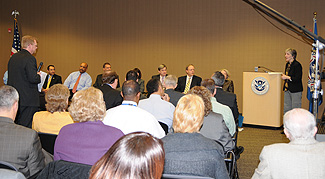
STSO Scott McKellips (on left), Dane County Regional Airport (Madison, Wis.), poses a question to leadership as other NAC members look on. Photo by Andy Szul
- Check iShare early next week to see the first local newsletter to be featured in the flashbox.

Situational Awareness, Footwear Lead to Jewelry Return
By Steven Grau, Evolution Support Center
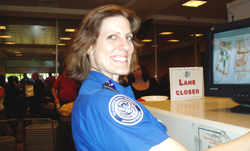
TSO Carrie Zertuche Photo Courtesy of Palm Springs
Recently at Palm Springs (Calif.) International Airport, TSO Carrie Zertuche applied newly acquired ENGAGE! skills to help return jewelry to a passenger.
It started when she was asked to conduct a bag check of a woman traveling with her husband. Aware of her surroundings, Zertuche's attention was drawn to a younger woman in the area traveling with a female companion wearing blue jeans and black boots.
After Zertuche cleared the bag, the passenger left the checkpoint but returned about an hour later. She said she could not find her watch or silver bracelet that she had placed in one of the white bowls before walking through the metal detector.
BDO Virginia Hardy was quickly engaged and she confirmed seeing the bowl with the jewelry in it an hour before. After a thorough search of the checkpoint area, the team determined that the passenger's watch and bracelet had been picked up by somebody else.
The team grew as Zertuche engaged Lead TSO Jack Horne and Supervisory TSO Jennifer Darr and told them she believed the woman's jewelry was with a girl traveling with a companion wearing black boots.
Together with Horne, Zertuche walked the terminals and restrooms looking for the woman with black boots. Not finding her, closed circuit tapes were reviewed and law enforcement was called to speak with the woman whose jewelry was missing.
With such a large team engaged in the effort, it took only 15 minutes before a young woman with black boots was spotted walking out of a restroom. Zertuche and Horne quickly went to where the woman and her traveling companion were spotted, and as they approached them, one of women quickly put out her hand with the watch and bracelet. She said it was a mistake and the airport law enforcement officer agreed – but warned the young women to be more careful.
"This shows that ENGAGE! training is working to develop situational awareness among our workforce," said Zertuche. "The result, in this case, was that valuable property was returned to its rightful owner resulting in a very grateful passenger and the prevention of what had appeared to be a theft."
Work Groups Embedding Evolution Principles into Operational Programs
By Michael Simons, Office of Strategic Communications/Public Affairs
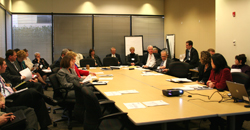
Security Evolution Operationalization Workgroup
Photo by Karen Knapik
About 90 percent of TSA's workforce has completed ENGAGE! and COACH! training and "the principles taught in that training must be operationalized," said Kim Whetsell, assistant general manager, Evolution Enterprise Integration.
As part of a comprehensive effort to do just that, the agency convened a working group last month to look in-depth at key operational tools such as job analysis tools (known as JATs). The February working group looked at AFSD, FSD and deputy area director positions. In January, a working group looked at TSO, lead TSO, supervisory TSO and manager positions.
"We are asking our frontline workforce to engage their networks and trust their guts," said Whetsell. "But how do you measure that under PASS, and how do you describe that in a job description? That's what we are looking at with these groups."
The job-description changes are being realized through a comprehensive, 360-degree process in which each position is defined by those in it as well as by those subordinate and superior to each role. For example, the job characteristics for the supervisory TSO were first laid out by a team of supervisory TSOs, then modified by a group of managers and a group of LTSOs.
As the groups build the foundation for changes to TSA's operational programs, deputy area directors are soliciting feedback about the work from internal stakeholders – in the field and at headquarters – about the preliminary results.
Ultimately, Security Evolution is about changing behavior, which is an ongoing process. "This is about embedding Evolution principles into the very culture we are trying to create," said Whetsell.
Evolution: In the FSD's Own Words
I continue to cherish the wonderful experience and opportunity to be a champion for Evolution. It is a privilege to be a part of the energy and passion of our Seattle-Tacoma and Bellingham teams as they embrace this historic change in our culture. The positive feedback from our passengers, stakeholders and DHS partners has been a true testimony of how our officers are truly committed to the empowerment of being "engaged." – FSD Denise E. Harvill, Seattle -Tacoma and Bellingham international airports
Engage the Evolution team with your questions and suggestions at ENGAGEevolution@dhs.gov.
News
Disaster Preparedness in Action
By Ignacio Reyes Jr., stakeholder relations manager, Austin-Bergstrom (Texas) International Airport
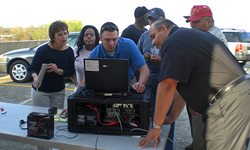
The hands-on training included using a high-frequency radio. From left, George Bush Intercontinental Airport (Houston) Coordination Center Officers (CCOs) Mary Morgan and Sabrina Adelkoya; from San Antonio International Airport, CCO Adam Mayes; Expert CCO Joe Gibson; STSO Efrain Briones; and TSM Adan Gonzales. Photo by Ignacio Reyes
The power lines are down. Wireless phones, blackberry devices and computers are not working. A senior agency official asks a group of TSA employees to send a damage assessment and status report to headquarters. The team sets up portable antennas, powers up battery-operated high-frequency (HF) radios and adjusts the tuning and transmits the information. The transmission was successful, ensuring that additional assistance will arrive.
That scenario, with participants from headquarters and the field, was part of TSA's Contingency Preparedness Program (CPP) held in San Antonio during the Communications Working Group Conference March 5-7. The training and conference focused on the contingency communications technology available to TSA in support of disaster operations.
As part of the exercise, participants developed emergency communications responses to address hurricane-disaster communications challenges. The training covered all modes of communications, including use of satellite phones and high-frequency Army MARS (military affiliate radio system) communications, site protection and setup training, licensing, and a practical demonstration as the final exam.
"TSA has excelled in disaster response operations in previous years," said Don Klapka, program manager, CPP. TSA has partnered with government agencies, including the Federal Emergency Management Agency, and departments of Defense and Homeland Security, in interoperability communications exercises that have enhanced TSA's ability to communicate during response efforts to Hurricanes Dolly, Gustav and Ike. "As TSA expands its coverage of transportation modes, so does the need for contingency experienced volunteers."
TSA's communications specialists supporting the CPP have received national and international recognition within the HF radio community. TSA trainers have also been featured in the industry magazine publications like QST, Amateur Radio CQ and World Radio.
If you are interested to learn more about local TSA preparedness training, contact your area emergency coordinators or FSD.
TSA Recognized for Its New Media Outreach Efforts
From the Office of Strategic Communications/Public Affairs

TSA is receiving widespread acclaim for its innovative use of new-media technology to communicate with the public and its employees. "Talk to any career Web professional in the federal government long enough, and sooner or later the TSA's blog comes up," said the White House on Feb. 27.
At nearly the same time as the White House shout-out, FEDTECH magazine highlighted TSA's successful use of next-generation Web tools – video sharing and social networking sites like YouTube and Facebook – to communicate with our workforce and traveling public.
TSA is also earning recognition for its IdeaFactory innovation. On Feb. 3, the National Journal (subscription needed) wrote, "Some agencies, like the Transportation Security Administration, are figuring out the Web on their own," and went on to say that most other agencies and departments are struggling to find valuable ways to incorporate the Web into their communication strategies.
Doing so has taken on greater urgency because President Barack Obama recently issued an executive memorandum that requires federal agencies to increase transparency, public participation and collaboration to strengthen democracy and promote effectiveness and efficiency in government. And the Web – with its new social networking tools – is an ideal place to meet that mandate.
So with its recent recognition from others and shared responsibility for increasing government transparency, TSA is applying its innovative character and can-do spirit in the service of other agencies. The IdeaFactory team, for example, has conducted briefings for NASA, the Office of Personnel Management, and the departments of Treasury, Justice, Commerce, Transportation, State, and Education.
Workforce on the Web
- Check out the new workforce story from California:
Officer's 'Great Observation' Nets Large Drug Find
Kudos & Clips
U.S Trains Airlines Operators on Safety, Security
By Chris Ochayi, Vanguard, March 18, 2009
The government of the United States yesterday commenced safety and security training for airlines operators, who have been designated to fly into the country. Read more.
Bradley International Uses Survey To Gauge Public Opinion
By Shawn R. Beals, The Hartford Courant, March 17, 2009
Bradley International Airport is well-liked by travelers, especially as an alternative to larger airports in Boston and New York, according to a recent survey conducted by the airport. Read more.
TSA Officers Receive Extra Communication Training
By Roni Martinez, KGBT-TV 4, March 13, 2009
Transportation Security Administration officers at our Rio Grande Valley airports learned useful communication skills Thursday. Read more.
TSA Experience
TSA Employee Honored for Volunteer Service to Colorado Springs Charity
By Carrie Harmon, Office of Strategic Communications/Public Affairs
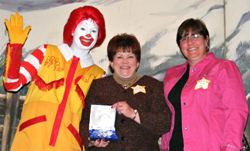
Kathie Howell (middle) is honored as 2008 Volunteer of the Year at the Ronald McDonald Family Room at Colorado Spring Memorial Hospital. At right is Tina Dewar, family room manager. Photo by Dave Ulmer
Kathie Howell, TSA representative to North American Aerospace Defense Command-USNORTHCOM in Colorado Springs, Colo., was recently named 2008 Volunteer of the Year at the Ronald McDonald Family Room, part of Ronald McDonald House Charities of Southern Colorado.
The Family Room, located at the Colorado Springs Memorial Hospital, is designed to provide a respite to families who have seriously ill children. Families can shower, access a laptop, do laundry, or bring their children to play. The room is staffed by volunteers. Howell was cited for her outstanding dedication and compassion.
"Kathie has truly embraced our organization and what we stand for," said Family Room Manager Tina Dewar. "In addition to the everyday responsibilities that come along with volunteering, she has truly become my right hand in helping to train new volunteers and will jump at any opportunity to do more."
"It doesn't surprise me that Kathie was chosen for this honor," said Vince Bousa, TSA liaison to NORAD-USNORTHCOM and Howell's supervisor. "It's clear that she shows the same qualities in her volunteer work as she does here at her job: dedication, determination and the desire to always go above and beyond."
"I take great joy in helping those in need," said Howell, who joined TSA in 2003. "Our volunteers are some of the most selfless people I've met. They give their time and themselves to the families and each other to ensure that the facility remains open to all who might need it."
More TSA Experiences
E-mail your comments and suggestions.



